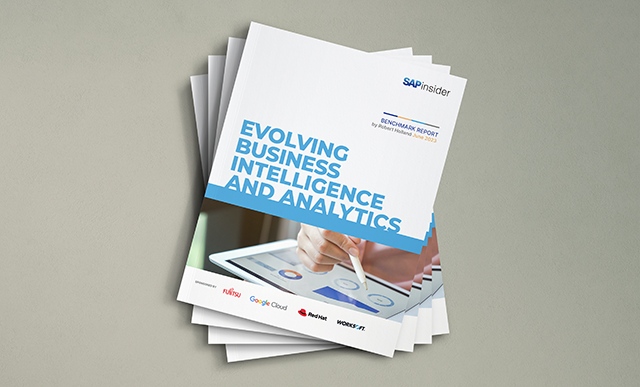The Role of Analytics for the Digital Enterprise
As oil was the currency that powered the Industrial Revolution, data is the currency that powers the Digital Revolution. Companies understand that by leveraging enterprise data — including the voluminous rise of unstructured data — to mine strategic insights, they very often gain a competitive advantage.
Companies that launch digital business initiatives do so with the prevailing mindset that data is an economic asset. While digital transformations are happening everywhere we look and in every industry, the concept of data as a true economic asset that is spurring the digital movement is actually relatively new. A decade ago, the macro trend was more representative of corporations undertaking global initiatives with a focus on data consolidation and data accuracy. One byproduct of this was an increase in operational reporting, with corporations analyzing what was happening in the business on a global scale.
This well-established trend is now evolving to companies trying to determine how to best use an influx of structured and unstructured data to drive maximum value for the business. Data as a true asset does more than tell what happened — it forecasts the direction a business must take based on all relevant data, including social sentiment. To digitize the enterprise is to create the environment that enables this approach.
IT budgets worldwide are being allocated to tackle digital initiatives, giving rise to a new wave of strategic questions: How will a digital framework enable the business to better reach and better serve customers and suppliers? How can existing assets be used or transformed to contribute to this outcome? How can existing data integrate with new waves of social data to shed light on buying patterns? Where are the quick wins?
A Stepping Stone to Real-Time Insight
Procuring the right enterprise software is just a small part of a successful digital transformation, which is defined more accurately by the business making decisions about where it wants to go, which processes it can reinvent, or which business models can be improved upon or even created anew with a digital core.
For SAP customers, developing a business case and a use case for SAP HANA helps answer many of the strategic questions surrounding the transition to a digital environment, and often starts organizations on a path toward bringing analytics into the business. This can take many paths, including:
- Migrating existing SAP Business Warehouse (SAP BW) solutions onto SAP HANA
- Transitioning to the newly architected SAP S/4HANA or SAP BW/4HANA
- Adopting SAP BusinessObjects Cloud, which integrates with core SAP on-premise solutions, and custom-built or third-party applications built on SAP HANA Cloud Platform
With any of these options, SAP HANA is often the stepping stone for companies to begin to mine enterprise data in new ways to derive business value. Many businesses that partner with IBM Global Business Services to drive innovation with the IBM and SAP Alliance are using SAP HANA in this way — for example, SAP HANA as a sidecar accelerator to supercharge CO-PA processes. While the original business case may be to speed up month-end processes, organizations can build upon these successes and have the confidence to explore further insights. The natural evolution leads to predictive analytics, where complex algorithms, for example, can be used to optimize working capital within treasury.
One of the challenges many organizations face in deciding how to best derive business value is that there are so few single-vendor, end-to-end IT environments anymore. With software-as-a-service (SaaS) applications, cloud application development platforms, and hybrid landscapes, organizations with increasingly patchwork environments can’t see the forest for the trees. Part of a digital transformation involves forming a cohesive view of how the company’s systems integrate, which can ensure that opportunities to extend analytics use cases are not wasted.
A Holistic Approach for Today’s Hybrid Landscape
Many companies recognize that a move to the cloud is the most cost-effective way to capture increasing data volumes, derive business value, and optimize a digital footprint. Because of today’s unprecedented increase in data volumes, companies recognize that outsourcing some or all of a cloud infrastructure to managed services is usually necessary to form a cohesive view of how integrated systems can return business insight.
This recognition, coupled with a compelling need to bring analytics into the enterprise, are the primary drivers leading companies to engage with IBM Cloud for SAP Applications as a digital transformation partner. With a focus on reducing cost and complexity while improving performance and resiliency, IBM Cloud for SAP Applications helps optimize SAP cloud landscapes and unlock digital opportunities. For companies running SAP HANA or considering a migration to SAP S/4HANA, this partnership often entails implementing advanced analytics solutions that run on SAP HANA to extract data without sacrificing performance.
One such path to a more robust analytics environment is IBM Cloud Analytics, a featured service in IBM Global Business Services. With this service, companies can leverage existing on-premise and cloud investments with ready-made apps that integrate with core business systems and tie in structured and unstructured data from multiple sources.
One recent integrated innovation is IBM technology that extracts unstructured input from a subscriber’s social network interactions and then provides those subscribers with tailored suggestions for products, promotions, services, travel bookings, and other customized offerings based on learned preferences. It works with IBM Watson User Modeling Service to analyze those social network interactions, and then mines a business subscriber’s back-end systems, such as SAP ERP or SAP CRM, to find the relevant product or promotion that reflects a user’s preferences.
Another example is IBM Metro Pulse, also powered by IBM Watson, which combines time-sensitive, hyper-local city data with an enterprise’s core business systems and applies cognitive computing to return location-specific opportunities. This provides a business with actionable intelligence so that it can act in advance of an event, basing its decision on a myriad of signals from a host of data sources. An insurance company, for example, might detect how a predicted hail storm would affect auto insurance claims for a particular geographic area. Or a retailer might analyze buying patterns to determine the optimal location for its next storefront.
Data and Digital Breakthroughs
The concept of enterprise BI today encompasses so much more; it draws on big data, data lakes, and dynamic tiering, and considers other ways to store and leverage massive amounts of data from which to draw business insights. There are so many new technologies that customers are no longer restrained as far as how to leverage and integrate existing investments. A best-of-breed landscape incorporates ideas and technologies from a host of vendors, and that is why it is so important to have a partner like IBM with the experience and SAP expertise to tie everything together to drive maximum business value.
The decision to become a real-time, digital enterprise that leverages data as an economic asset isn’t taken lightly; at least a portion of the journey is a path down the unknown.
The decision to become a real-time, digital enterprise that leverages data as an economic asset isn’t taken lightly. Companies do so with the tacit acknowledgement that at least a portion of the journey is a path down the unknown. This is understandable; the journey itself is so revolutionary that companies cannot reasonably expect to grasp all of the potential outcomes as a result of transitioning to a data-first, data-driven organization. By leveraging IBM’s deep experience as an SAP digital transformation partner, organizations can confidently take the first step in their digital journeys knowing that they have a trusted guide with them every step of the way.
To learn more, go to www.ibm.com/analytics or visit www-935.ibm.com/services/us/en/sap/solutions/consulting.html.







